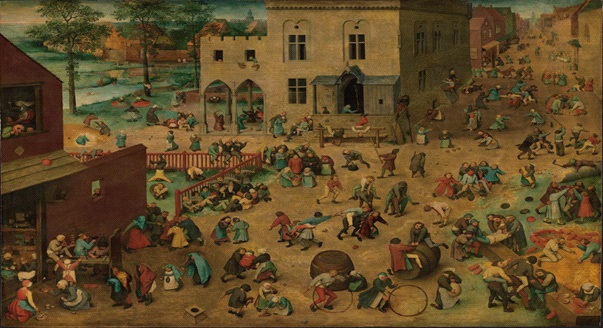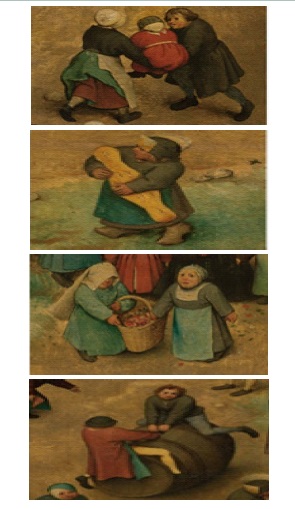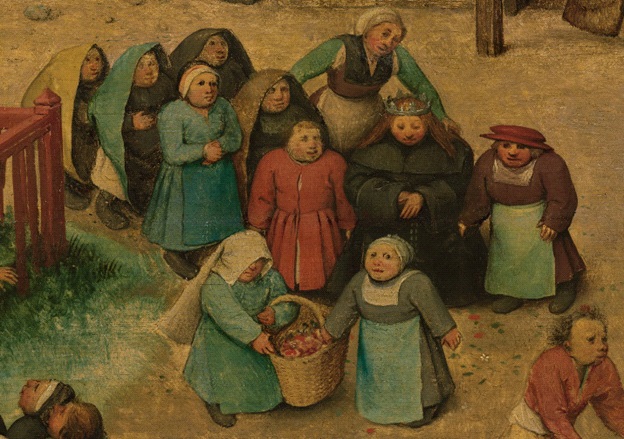
Journal of Clinical Images and Medical Case Reports
ISSN 2766-7820
Short Commentary - Open Access, Volume 3
Art and pediatric orthopaedics: Pieter Bruegel and children’s games
Vij N1; Belthur M1; Belthur MV2*
1 University of Arizona College of Medicine – Phoenix, 475 N 5th St., Phoenix, AZ 85004, USA.
2 Phoenix Children’s Hospital, Department of Orthopedics, Main Building, Clinic B, 1919 E , Thomas Rd, Phoenix, AZ 85016, USA.
*Corresponding Author: Mohan V Belthur
Phoenix Children’s Hospital, Department of Orthopedics, Main Building, Clinic B, 1919 E , Thomas Rd,
Phoenix, AZ 85016, USA.
Email: mvbelthur@yahoo.com
Received : Dec 16, 2021
Accepted : Feb 25, 2022
Published : Mar 04, 2022
Archived : www.jcimcr.org
Copyright : © Belthur MV (2022).
Abstract
Pieter Bruegel’s “The Children’s Games” demonstrates a wide age range of children participating in a known therapeutic and preventative measure --outdoor play. An interpretation of captivating oil-onwood masterpiece in the context of recent pediatric and pediatric orthopedic literature is given.
Keywords: art; outdoor play; vitamin D; parent-children relations; pediatric orthopedics.
Citation: Vij N, Belthur M, Belthur MV. Art and pediatric orthopaedics: Pieter Bruegel and children’s games. J Clin Images Med Case Rep. 2022; 3(3): 1713.
The artist
Pieter Bruegel the Elder (Figure 1) was an important Flemish artist, renowned for his Dutch and Flemish Renaissance paintings [1,2]. He was born in 1525 in Breda, Netherlands and died on 9 September 1569 in Brussels, Belgium. Bruegel lived during a time of extensive change in Western Europe. He developed his skills under the tutelage of the painter, Pieter Coecke van Aelst at the guild of St. Luke from 1545-1550 and graduated from the Antwerp artists guild in 1551. He travelled to Rome, Italy in 1553-4, and was influenced by the illuminator and miniature painter, Giulio Clovio before returning to Antwerp in 1555. Between 1555-1558, Bruegel continued his journey into the world of prints and became a designer of prints for a leading publisher. He finally settled down permanently in Brussels in 1563 [1,2].
His down to earth, dispassionate but evocative depiction of the rituals of village life served as unique windows on a vanished folk culture and a prime source of iconographic evidence about both physical and social aspects of 16th-century life. As one of the first artists to have grown up in a time where artwork was less centered around religious ideas, much of his work focused on secular concepts. Bruegel’s art was also quite popular because it embraced the new ideas of society and enhanced artistic concepts from the medieval era.
The work of art
Children’s Games (Figure 2) [3] is an oil on wood panel landscape painting completed in 1560 and is currently exhibited at the Kunsthistorisches Museum in Vienna [1]. It was acquired by the Archduke Ernest von Österreich (son of the Holy Roman Emperor Maximillian II) of Austria in 1594.
The painting provides a panoramic view of a large city square with transition from an urban to a rural setting at the corners of the painting. On the right side the landscape opens on to a long street laid out in central perspective and leading to the city center, where a church steeple soars into the sky. On the left side of the painting, an idyllic village appears on the horizon.
It beautifully portrays the different recreational activities (83 games) of village children of all ages (230 in number). The children, who range in age from toddlers to adolescents, roll hoops, walk on stilts, spin hoops, ride hobbyhorses, stage mock tournaments, play leapfrog and blind man’s bluff, perform handstands, inflate pigs’ bladders, and play with dolls and other toys. This crowded scene is to some extent relieved by the landscape in the top left-hand corner; but even here children are bathing in the river and playing on its banks.
The chaos of this area, with all the children playing, indicates the importance of it in this society. Furthermore, the children seem to be handling their play with a particular seriousness and focus which is reminiscent of how adults handle their work.
Relevance to pediatrics and pediatric orthopedics
Much regarding the field of pediatrics can be gleamed from this work of art. One can note that children are seeing playing throughout the stages of development (Figure 3). This display is demonstrates just how important play is for a child’s growth and development not only in their early years but throughout their childhood and adolescence. Playing is a child’s “occupation” and is important, to develop physical coordination, emotional maturity, social skills to interact with other children, and self-confidence to try new experiences and explore new environments [4,5]. A recent article emphasizes the importance in child play [6] in maintaining strong parent-child bonds and this too can be gleamed from the painting (Figure 4).
The concept of children’s play has an intimate relationship with learning which includes cognition, locomotor skills, problem-solving abilities, dealing with stressful situations and creativity [4]. Play is necessary for children to gain experience in using certain social skills such as interacting with new people, cooperating in a group setting and working as a team to achieve a greater goal [4]. Additionally, play allows children to develop the ability to concentrate and focus their attention for longer periods of time.
This oil on wood masterpiece also elucidates several points within pediatric orthopedics. Physical strength as well as the development and growth of a child’s bones results from the many days children spend playing. Based on the amount of daylight and absence of leaves near the stream (top left, Figure 2), one could presume the setting to be in Summer. A recent review article demonstrates the many roles that vitamin D plays in the musculoskeletal system including correlation with injury incidence and surgical outcomes [7]. The painting underscores this point by depicting a scene of 83 games and 230 children playing during the summer months. Of note, there is a seasonal relationship with pediatric fracture incidence, which too can also be gleamed by the astute observer [8].
Focusing our attention on the top left once again, we see a young swimmer in the stream with two comrades watching. This is in line with the notion that swimming in school-aged children can be a useful rehabilitation tool but should always be accompanies by others [9]. A parental figure can be seen not too far from the stream, albeit distracted, which sheds light on the dangers that bodies of water pose too children.
References
- The complete works. Pieter the Elder Bruegel [Internet]. [cited 2021 Jul 9]; Available from: https://www.pieter-bruegel-theelder.org/
- Kunst Historisches Museum Wien. Inside Bruegel [Internet]. Available from: https://www.insidebruegel.net/
- Kunsthistorisches Museum Wien. 130 Jahre. Picture Gallery. [Internet]. Available from: https://www.khm.at/en/collections/ picture-gallery
- Yogman M, Garner A, Hutchinson J, et al. The power of play: A pediatric role in enhancing development in young children. Pediatrics. 2018; 142.
- Milteer RM, Ginsburg KR, Mulligan DA, et al. The importance of play in promoting healthy child development and maintaining strong parent-child bond: Focus on children in poverty. Pediatrics. 2012; 129.
- Ginsburg KR, Shifrin DL, Broughton DD, et al. The importance of play in promoting healthy child development and maintaining strong parent-child bonds. Pediatrics. 2007; 119.
- Moon AS, Boudreau S, Mussell E, et al. Current concepts in vitamin D and orthopaedic surgery. Orthop. Traumatol. Surg. Res. 2019; 105.
- Segal D, Slevin O, Aliev E, et al. Trends in the seasonal variation of paediatric fractures. J Child Orthop. 2018; 12.
- Fragala-Pinkham MA, Dumas HM, Barlow CA, et al. An aquatic physical therapy program at a pediatric rehabilitation hospital: A case series. Pediatr Phys Ther. 2009; 21.




